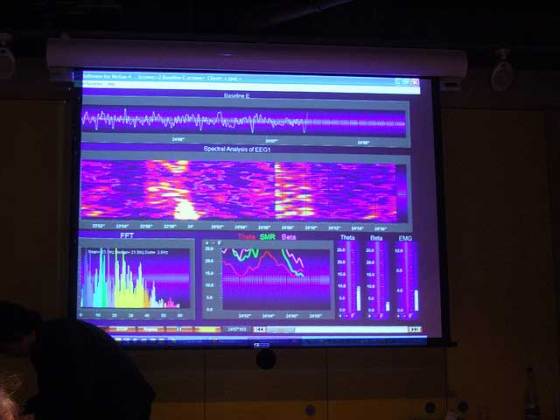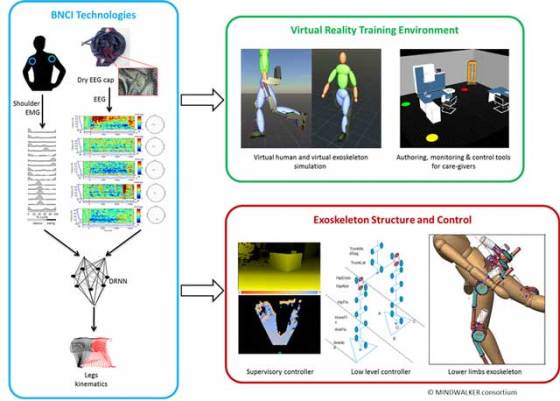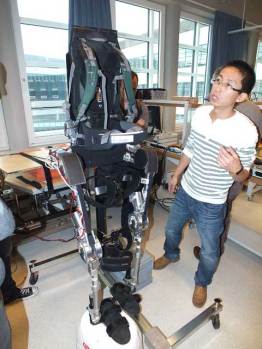Mindwalker – mind-controlled exoskeleton could help disabled people
 An international group of researchers from Europe is working on the Mind-controlled orthosis and VR-training environment for walk empowering (Mindwalker) project – a project where they devise a system that could help individuals with spinal cord injury. Aside helping people with spinal cord injury, this combination of an exoskeleton and a brain-machine interface could also be used in muscle rehabilitation.
An international group of researchers from Europe is working on the Mind-controlled orthosis and VR-training environment for walk empowering (Mindwalker) project – a project where they devise a system that could help individuals with spinal cord injury. Aside helping people with spinal cord injury, this combination of an exoskeleton and a brain-machine interface could also be used in muscle rehabilitation.
The team’s approach relies on an advanced Brain/Neuronal Computer Interaction (BNCI) system that converts electrical signals from the body into electronic commands to control the exoskeleton. Since several research groups work on this project, there are different solutions that are being developed. Some of them rely on electroencephalography (EEG) signals from the brain, electromyography (EMG) signals from shoulder muscles, or a combination of both.
One approach for controlling the exoskeleton uses steady-state visually evoked potential – a method that reads flickering visual stimuli produced at different frequencies to induce correlated EEG signals. Detection of these EEG signals is used to trigger commands such to stand, walk, move faster or slower.
A second approach is based on processing EMG signals generated by the user’s shoulders. When we walk, our arms and legs are coordinated. This enables conversion of arm-swinging patterns into signals that control the movement of the exoskeleton’s legs.
Third approach, which is most interesting and complex, relies on identification and exploitation of EEG Theta cortical signals produced by the natural mental process associated with walking. Unfortunately, its complexity and time needed to develop such a system didn’t match the project’s timeframe of three years, so it had to be dropped by the Mindwalker team.
Although I’m personally most interested in the last approach, you have to be familiarized with the difficulties it encounters with our current knowledge and technology. While every research group is familiar with this technology, and we have various Brain Machine Interfaces (BMIs), you have to be familiar with some facts that currently work against this approach.
To get better signal reading, you would have to use invasive methods and drill into the skull to place the sensors placed directly into brain tissue, or require users to wear a “wet cap” with sensors on their head.Aside the fact non-invasive methods can be used to read less precise signals, there’s a lot of noise which occurs due to our facial expressions and movement. When it comes to its use, the method requires long training to adapt to its user, as well as user’s training to focus at certain things to perform a task.
Mindwalker project
Mindwalker team adopted a ‘dry’ EEG reading technology developed by Berlin-based eemagine Medical Imaging Solutions. It is a cap covered in electrodes that the user can fit themselves, and which uses a propriety technology with electronic components to amplify and optimize signals before sending them to the neural network which processes these signals in order to create signals which control the exoskeleton.
To achieve this, the Mindwalker team fed the signals into a Dynamic recurrent neural network (DRNN), a processing technique capable of learning and exploiting the dynamic character of the BNCI signals.
The universities of Delft and Twente in the Netherlands proposed the design of the exoskeleton and its control. Compared to other exoskeletons developed to date it is relatively light, weighing less than 30kg (66lbs) without batteries, and, because a final version of the system should be self-powered, it is designed to minimize energy consumption.
Mindwalker researchers achieved energy efficiency through the use of springs fitted inside the joints that are capable of absorbing and recovering some of the energy otherwise dissipated during walking, and through the development of an efficient strategy for controlling the exoskeleton.
The exoskeleton is designed to bear the weight of a 100kg (220lbs) person. Unlike Zero Moment Point (ZMP) designed exoskeletons, which are designed to be balanced when stationary or quasi-static, and they move by little steps inside their ground stability perimeter, Mindwalker exoskeleton relies on a more advanced and more natural control strategy which mimics the way humans actually walk, with a controlled loss of balance in the walking direction.
”This approach is called ‘Limit-cycle walking’ and has been implemented using model predictive control to predict the behavior of the user and exoskeleton and for controlling the exoskeleton during the walk. This was the approach investigated in Mindwalker”, said Michel Ilzkovitz, the project coordinator at Space Applications Services in Belgium.
Mindwalker exoskeleton is powerful enough to recover balance if the system reaches a state of instability, such as the user’s own torso movements during walking or a gentle push from the back or side.
To train users to control the exoskeleton, researchers from Space Applications Services developed a virtual-reality training platform, providing an immersive environment in which new users can safely become accustomed to using the system before testing it out in a clinical setting, and, the team hope, eventually using it in everyday life.
By the end of this year, tests with able-bodied trial users will be completed. The system will then be transferred to the Foundation Santa Lucia for conducting a clinical evaluation until May 2013 with five to 10 volunteers suffering from spinal cord injuries. These trials will help identify shortcomings and any areas of performance improvement, the project coordinator says.
Aside helping individuals with spinal cord injury, elements of the system could be adapted for the rehabilitation of stroke victims or to develop easy-to-use exoskeletons for elderly people for mobility support. It could also be used in muscle rehabilitation after surgery or other trauma, as well as to rehabilitate muscles of astronauts after prolonged periods in space.












Leave your response!